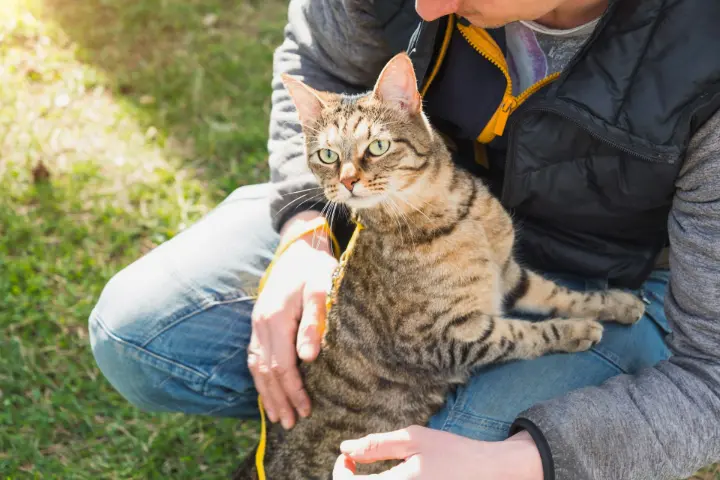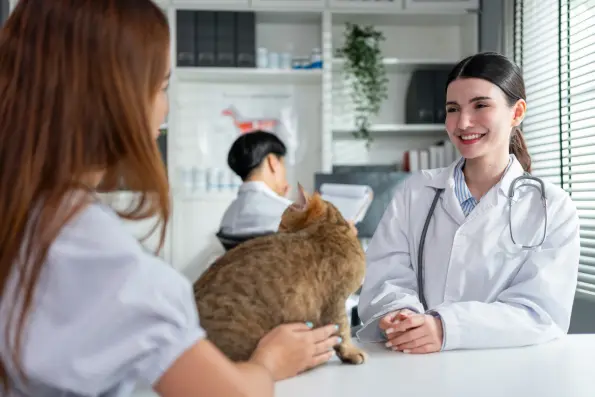According to a 2025 Vetsource white paper analyzing data from over 6,500 veterinary practices, overall veterinary visits are down 2.3%. The time between client visits has stretched by 48% compared to three years ago.
Everyone's talking about the decline in veterinary demand. But there's one segment that's defying gravity.
Cats.
While dog visits continue a downward slide, feline visits have been steadily climbing since early 2023, according to the CATalyst Council's 2025 Market Insights Report. This isn't just a blip. It's a fundamental shift in the market that smart practices can capitalize on.
If you're not paying attention to this trend, you're leaving serious money on the table.
Understanding the opportunity
According to a Freedonia Group report, cats represent a $43 billion market - that's 30% of the entire pet industry. And it gets more interesting. Morgan Stanley research shows that while overall pet ownership has stayed flat at 69%, cat ownership is actually increasing while dog ownership declines.
In an industry where everyone's fighting for a shrinking pie, the cat segment is actually growing.
Why? Economics and lifestyle changes. More people are returning to offices. Urban living is on the rise. Younger generations are dealing with smaller spaces and busier schedules. And cats? They fit perfectly into this new reality.
But most practices are still operating like it's 2019, with a focus on dogs while treating cats as a secondary patient group.
The real kicker, though, is that cat owners spend differently than dog owners. They're looking for specific services, have different pain points, and respond to completely different messaging. Miss these differences and you miss the opportunity.
Why cat owners are different (and how to reach them)
You probably know this, but you might not think deeply about it.
According to 2024 veterinary statistics from Otto, millennials are now the largest pet-owning generation, making up 33% of all pet owners. And they prefer cats.
But reaching cat owners isn't just about demographics. It's about understanding their unique challenges.
The biggest one? Actually getting the cat to your clinic.
Every cat owner has that story.
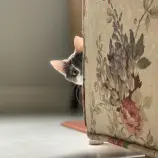
The carrier comes out.

The cat disappears.
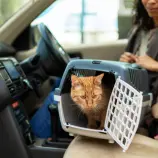
The car ride sounds like you're torturing them.
By the time they get to your clinic, both owner and cat are stressed.
Dog owners might skip a visit because of cost.
Cat owners skip visits because the whole experience feels like trauma for everyone involved. That's a completely different problem requiring a completely different solution.
The cat parent mindset is fundamentally different too. They're not looking for the same services dog owners want. They're dealing with indoor-only pets who seem fine until they're really not. They need education about why prevention matters when their cat never leaves the house. They want to know you understand cats aren't just small dogs.
Making your practice cat-friendly (without revamping your budget)
You don't need a million-dollar renovation to capture the cat market. You need smart, targeted changes that actually address what keeps cat owners away.
Start with separate waiting areas.
A separate cat waiting area doesn't mean building an addition. It can be as simple as using your exam rooms differently. Schedule cat appointments back-to-back and use one exam room as a cat waiting area. Instant separation, zero construction costs.
Staff training matters more than any physical change you could make. Teach your team to speak cat. That means understanding that cats aren't being difficult. They're being cats. Low voices, slow movements, and patience aren't just nice-to-haves. They're the difference between a cat owner who comes back and one who doesn't.
And about that equipment. Remember our IV pump survey? According to AIV-Vet's 2025 Veterinary IV Pump Survey, 87% of vets said workflows vary between routine and critical care.
For cats, this variation is even more pronounced. Stressed cats need different protocols. Their smaller size demands more precision. Having equipment that can handle these variations isn't just about better medicine - it's about efficiency that keeps cat appointments profitable.

Services that cat owners actually want
Stop trying to sell cat owners dog services with a feline twist. They want services designed specifically for their indoor cats.
Preventive care packages for indoor cats should look different. Yes, they still need vaccines, but the conversation is different. It's about explaining:
Why an indoor cat needs protection.
What parasites can come in on your shoes.
Document and report any suspected food-related issues to your state authorities.
Senior cat wellness programs are your biggest opportunity. Cats are living longer, and according to PetMD and AAHA guidelines, those over-10 cats need twice-yearly visits.
But generally, their owners often don't know this. They see a cat who sleeps 20 hours a day and think that's normal aging. You know it could be pain, kidney disease, or hyperthyroidism.
Stress-free handling isn't just a nice marketing term. It's what keeps cat owners coming back. When you can examine a cat without turning it into WrestleMania, owners notice. They tell their friends. They actually schedule that next appointment.
And fluid therapy? It's a huge part of feline medicine. From chronic kidney disease to simple dehydration, cats need fluids more often than dogs. Having efficient, reliable fluid delivery systems is about being able to offer services like subcutaneous fluid administration training for owners (or something similarly unique to your area). That's a revenue stream most practices completely miss.
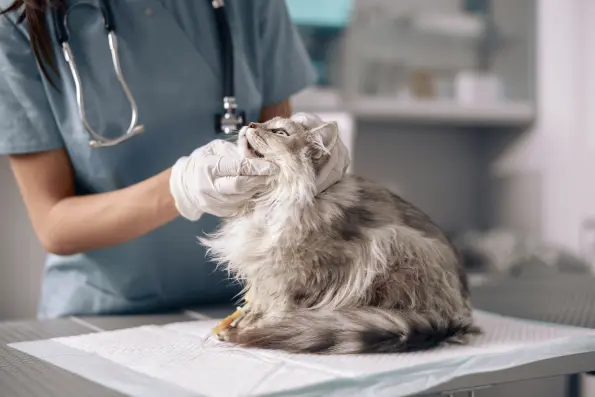
Marketing to cat owners is not like marketing to dog owners
Your Facebook posts full of golden retrievers aren't reaching cat owners. They've already decided you're a dog place.
Digital strategies for cat parents need to acknowledge their reality. Share content about why indoor cats need vet care. Make videos showing your calm cat handling techniques. Post about the carrier training you offer. Show them you get it.
August 22 is Take Your Cat to the Vet Day. This should be your Black Friday. Plan a campaign in advance. Offer carrier training classes next June. Send reminders about overdue vaccines. Create a scared cat package with pre-visit pharmaceuticals and a specific appointment protocol.
Building relationships with cat owners is tricky because you see them less frequently. That's why you need to be more intentional. Birthday cards for cats. Reminder texts about senior screening. Follow-up calls after stressful visits. These touchpoints matter more when natural touchpoints are fewer.
And never talk callously about how all cats hate vet visits. Every time you joke about it, you're giving owners permission to skip visits. Instead, talk about your zen cat protocols. Share success stories. Show cats who are calm at your clinic. Change the narrative, change the behavior.
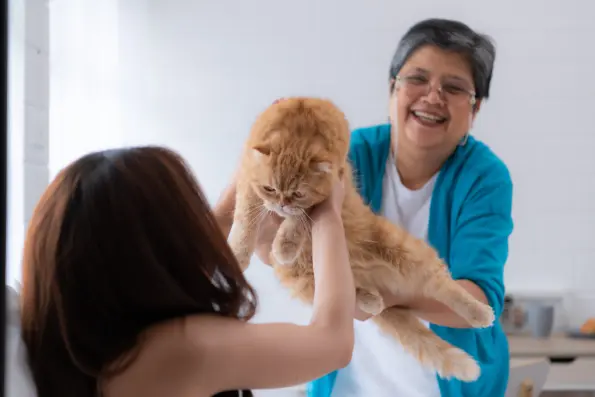
The business case
According to Otto's 2024 veterinary statistics, the average dog owner spends $730 annually on veterinary care. Cat owners spend less per visit but there are still 46.5 million cat-owning households. That's a huge market to increase your penetration into.
Increasing visit frequency for cats doesn't mean being pushy. It means education. Most cat owners don't know senior cats need twice-yearly visits. They don't realize weight loss in cats is always significant. They think their cat's behavior changes are just personality, not pain. According to the AVMA's 2025 economic report, this education gap represents one of the biggest opportunities in veterinary medicine.
Membership programs for cats work differently than for dogs. Annual packages that include unlimited help, but you can also bundle services they really need - annual bloodwork, dental cleanings, and those senior screenings. Price it right and you'll see steady revenue from clients who otherwise visit sporadically.
Equipment investments pay off faster in feline medicine. That IV pump that handles low flow rates precisely? Essential for cats. Fluid warmers? Critical for feline surgery. These are tools that let you practice better medicine efficiently.
The writing is on the wall
The practices thriving right now aren't the ones waiting for dog visits to rebound. They're the ones who saw the cat opportunity and grabbed it.
Here are three things you can do this week.
Audit your current cat versus dog numbers. What percentage of your practice is feline? If it's under 30%, you're missing the market.
Schedule a team meeting specifically about cat handling. Not general fear-free training - specific cat protocols. How do you handle carriers? What's your stressed cat protocol? Get everyone on the same page.
Look at your marketing materials. If cats are less than 30% of your imagery and messaging, you're telling cat owners you're not for them. Fix it.
The practices that get this right can thrive. Because while everyone else is fighting over a shrinking pool of dog visits, you'll be serving the one segment that's actually growing.
Cats aren't just small dogs (as you know). And cat owners aren't just pet owners who happen to have cats. They're a distinct market with distinct needs and distinct opportunities.
The question isn't whether you should focus on feline healthcare. It's whether you'll do it before your competition figures it out.
Because they will.
Sources:
1. Vetsource | Behavior shift: Implications of today’s pet owner trends on veterinary medicine in 2025
2. Business Wire | CATalyst Council | Market Insights Report
3. Freedonia Group |Cats: US Pet Market Trends and Opportunities, 2nd Edition
4. Morgan Stanley | Pet Care Industry Outlook
5. Otto | 2024 Vet Statistics
6. PetMD/AAHA | How often to take your cat to the veterinarian
7. DVM 360 | 2025 economic state of the veterinary profession: Trends and opportunities for your Practice
